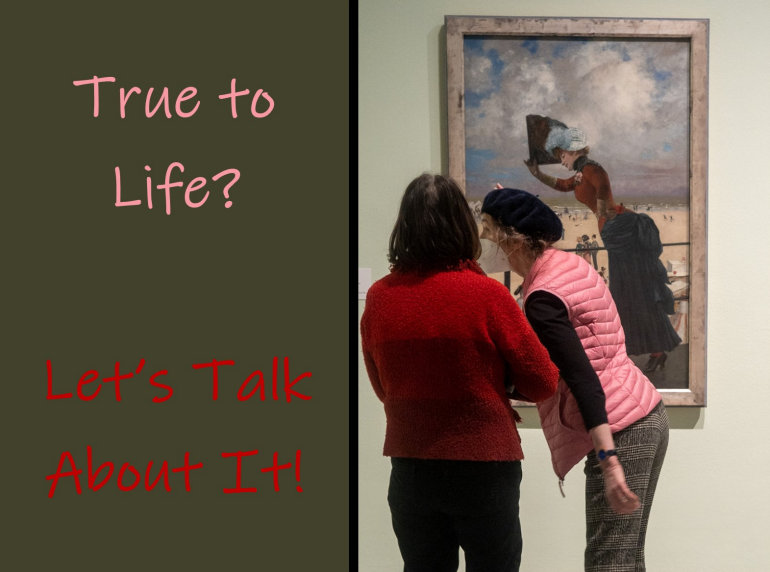ART: The first hour of each class will consist of a number of comparisons like the one below, which I offer as an advance sample. This image, and all other similar ones with a star in the bottom corner, can be clicked on to show each of the pictures at larger size. The questions underneath it are samples of the ones I may ask in class. Think about them now, to get the ball rolling. rb.



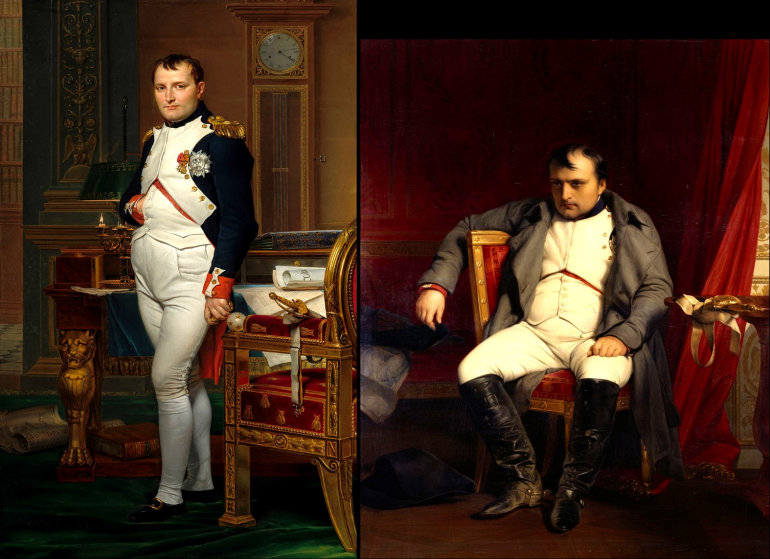
Some questions: Which of the three paintings seems the most atmospheric, and which the most anchored? Is the principle of composition the same in each case? How might you compare the use of human figures in the two pictures that include them? What aspect(s) of reality seem of greatest interest to each artist?
MUSIC: The three Debussy Preludes that we shall compare during the second hour can
be heard here; they are given in audio only and without titles,
since the object of the comparison is to hear how far so-called "Impressionist" music can succeed in creating a sense of place.
These will be played in class, so listen in advance only if you want to.
POETRY: We will also compare descriptive poems from the early 20th century; their texts can be found here, together with the full text of a Rupert Brooke poem that I shall also play.
PEOPLE: Here are brief bios of the painters and poets shown in the class.
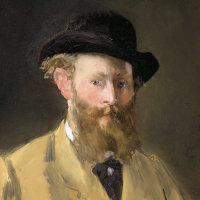 |
Édouard Manet, 1832–83. French painter. Manet is arguably the greatest French painter in the third quarter of the 19th century. Though primarily a realist, he was influenced by older artists such as Titian and Velasquez. He was admired by the young Impressionists, became friends with Monet, and produced a number of works in their style, but he never exhibited with them, preferring to retain his own status in the official Salons. |
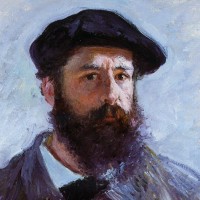 |
Claude Monet, 1840–1926. French painter. The central figure in Impressionism (it was his Impression: Sunrise of 1872 that gave the movement its name), he intensified its focus more than any other artist, continuing well into the next century to produce series of paintings showing minute variations in the light and color in basically the same scene. Cézanne famously said of him, "Monet is nothing but an eye—but my God, what an eye!" |
 |
Jean Béraud, 1849–1935. French painter. "Béraud was renowned for his numerous paintings depicting the life of Paris, and the nightlife of Paris society, [all] precisely detailed illustrations of Parisian life during the Belle Époque." [Wikipedia] |
 |
Rupert Brooke, 1887–1915. English poet. Brooke is today best known for his 1914 sonnet The Soldier ("If I should die, think only this of me"), which maintained a nobility that other war poets decried. Strikingly handsome (Yeats called him "the handsomest young man in Engand"), he had achieved great popularity before he died of sepsis from a mosquito bite on the way to Gallipoli. |
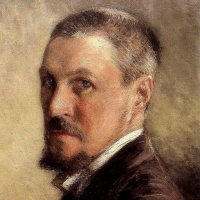 |
Gustave Caillebotte, 1848–94. French painter and collector. Caillebotte took part in five of the eight Impressionist exhibitions, showing depictions of contemporary life often distinguished by unusual framing and viewpoints. But as he was a wealthy man, his greatest contribution may have been the financial support he gave to many of the artists, his purchase of many of their works, and his bequest of the entire collection to the state. |
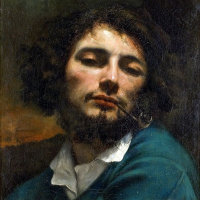 |
Gustave Courbet, 1819–77. French painter. A fiercely realist painter who stood proudly outside the academic tradition, Courbet was nonetheless one of the most powerful figures in 19th-century French art. |
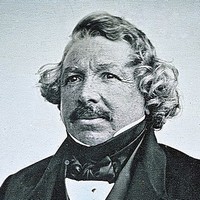 |
Louis Daguerre, 1787–1851. French photographer and designer. Working originally with Nicéphore Niépce, Daguerre perfected the daguerrotype process of photography. It was hailed as a revolution. The French government purchased the rights in exchange for a lifetime pension, and then published the methods as "France's gift to the world." Daguerre was also an accomplished designer and scene-painter. |
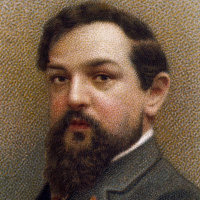 |
Claude Debussy, 1862–1918. French composer. Debussy was one of the most original French composers of the 20th century and, with Ravel, the prime exponent of what is commonly called Impressionism, the creation of musical images through harmony, texture, and scraps of melody. Although an exquisite orchestrator, his most original works are probably those written originally for piano, including two books of Préludes from the last years of his life. |
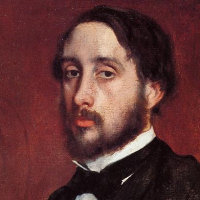 |
Edgar Degas, 1834–1917. French painter and sculptor. The son of a wealthy banker, he originally trained for the law. When he did go into art, he painted mostly traditional subjects until Manet introduced him to the Impressionists, at which point he turned entirely to scenes from everyday life. Although he was the only artist to participate in all eight Impressionist shows, he strongly resisted the term, and pursued his own quite original course. |
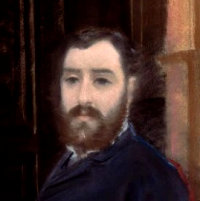 |
Giuseppe De Nittis, 1846–84. Italian painter. After training in Italy, De Nittis moved to Paris, where he had some success with genre paintings exhibited at the Salon. Degas invited him to take part in the first Impressionist exhibition in 1874, but the others did not entirely accept him, and thereafter he continued on his own, frequently using pastels rather than oil paints. |
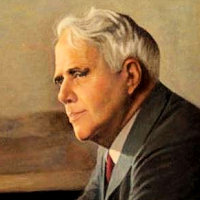 |
Robert Frost, 1874–1963. American poet. Finding little success in America, Frost moved with his family to England in 1912, where his quality was recognized by then-critic (and later poet) Edward Thomas. Frost returned to America in 1914, and built a reputation as the bard of rural New England and latterly America's best-known poet. |
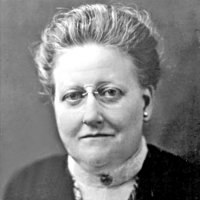 |
Amy Lowell, 1874–1925. American poet. Lowell, a member of the famous Boston family, did not go to college because her father thought it improper for women to do so. Nevertheless, she turned to poetry at the age of 28, met Ezra Pound some years later, and became one of the leading exponents of the Imagist school. She is one of the few people to be awarded the Pultizer Prize posthumously. |
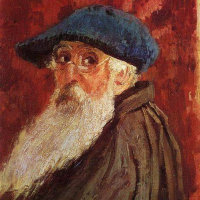 |
Camille Pissarro, 1830–1903. French painter. Born in the West Indes, where his father was a successful planter, he did not settle in Paris until 1855. Shortly thereafter, he met Monet, and with him became a central figure of Impressionism. He was the only artist to take part in all eight exhibitions, and the only one not to diverge into a distinctly different style. |
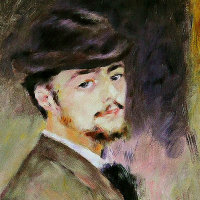 |
Pierre-Auguste Renoir, 1841–1919. French painter. A leading member of the Impressionist group, he began his career as a china painter in the Limoges factory, which—together with his admiration of Rococo masters such as Watteau and Fragonard—may have influenced the sweetness of color seen in much of his work. He was more concerned with detail, and more interested in figures than most of his colleagues. |
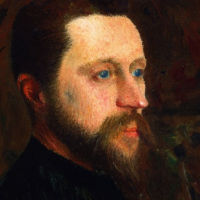 |
Georges Seurat, 1859–91. French painter. Seurat exhibited his masterpiece, Sunday Afternoon on the Grande Jatte, at the last Impressionst exhibition (1886), but he was never really one of their group, sketching out of doors, but preferring to work up his carefully balanced compositions in the studio. His formalization of the Impressionist technique of using contrasting colors in small brushstrokes led to the style known as pointillism or Neo-Impressionism, of which he was the founder. |
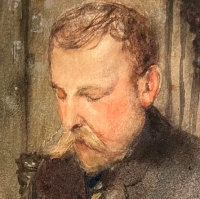 |
Franz Skarbina, 1849–1910. German painter. A professor at the Prussian Academy of Arts in Berlin, where he had studied himself, Skarbina made frequent trips to France, where he absorbed something of the influence of the Impressionists. |
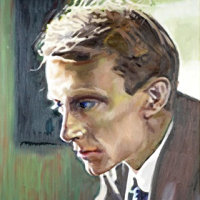 |
Edward Thomas, 1878–1917. English poet. At the time he met Robert Frost in 1912, Thomas was known primarily as a critic, and as the author of numerous books about the English countryside. Frost encouraged him to kindle his prose into verse, resulting in a small but intense lyrical output before he was killed in the First World War. |
ART: For the paintings discussed (or intended to be discussed) in class see below. Scroll to the end or click these links to reach the sections on MUSIC/POETRY and BIOS.
COMPARISON 1




Some questions: Which of the three paintings seems the most atmospheric, and which the most anchored? Is the principle of composition the same in each case? How would you compare the use of human figures in the two pictures that include them? What aspect(s) of reality seem of greatest interest to each artist?
Some facts: Claude Monet (1840–1926) went to London in 1870–71 in self-imposed exile to escape the Franco-Prussian War. He painted dozens of similar scenes during this time, but it was not until the 1890s that he began his series of paintings (eg. Haystacks, Rouen Cathedral) showing the same subject under different atmospheric conditions. Giuseppe De Nittis (1846–84), exhibited at the first Impressionist Exhibition in 1874, and thereafter went his own way, probably because his interest in the social aspects of his subjects did not match the purely visual impulse of the other Impressionists.
COMPARISON 2




Some questions: Which picture looks most like a color photograph? Which might you most want to use in a tourist brochure? What is the role of the man-made objects in each? What can each tell us about the way the people enjoy their leisure? What social class is represented in each? Define it how you will, which painting is the most idealised?
Some facts: Gustave Courbet (1819–77) was admired by many of the Impressionists for his realism, and he is known to have encouraged Monet. Georges Seurat (1859–91) did not exhibit with the Impressionists until their last show in 1876, two years after Bathers was painted, but this earlier work already shows the beginning of his pointillist style, combined with the strong classicism of his organization.
COMPARISON 3




Some questions: Two of these pictures have almost the same composition; what are the differences between them? If choosing between them for a tourist brochure, would each appeal to the same clientele? What does either of them tell you about French social life in 1870? What is Monet's interest in focusing down on the two women in the third picture?
Some facts: Monet's paintings of the Atlantic resort of Trouville all date from the summer of 1870; they are among the first examples of him painting multiple views of the same location. The comparatively large emphasis on social elements would be unusual in his later work. Even so, it contrasts quite strongly with the beach scene by the German artist Franz Skarbina (1849–1910) below. Although he made several visits to Paris and was influence by the Impressionists, his narrative interest equals or trumps the visual one.
COMPARISON 4



Some questions: The Manet contains figures; is it a portrait? And if not, why not? The Monet painting is obviously the background of the Manet, without the railings: which picture has the greatest sense of depth? What can you say about the composition of each? Take the terms "lens" and "frame": how would they apply? What is the darkest color in each, and the lightest? How does each artist treat the steam? Why do you think each painter chose to do his picture there?
Some facts: For his sitter, Édouard Manet (1832–83) used Victorine Meurent, who was also the model for his Luncheon on the Grass and Olympia; she was also a painter. One of the buildings visible behind the railway cutting is the apartment block where Manet was living at the time. While this setting was unique in Manet's work, Monet made about a dozen paintings of the station.
COMPARISON 5




Some questions: How would you rank these three pictures in terms of truth to place, truth to atmosphere, and truth to social detail? In prioritizing one of these over the others, what compromises has each artist had to make?
Some facts: Camille Pissarro (1830–1903) was the only artist to take part in all eight Impressionist exhibitions, and the one who remained most true to the original style. So although this is a late work, it is still Impressionist in manner, whereas Pierre-Auguste Renoir (1841–1919) had already moved to a different style by this time. Jean Béraud (1849–1935) made his name painting scenes of Parisian life like this one, but his interest was mostly in the realistic and often witty treatment of the figures that he showed in such detail. The early daguerrotype below by Louis Daguerre (1787–1851) may be the first photograph of a Paris street. Although it seems empty, this is because of the long exposure times; the only figures seen are the motionless boot-black and his customer frozen at corner of the sidewalk.

Daguerre: Boulevard du Temple, 8:00 AM (1838)
COMPARISON 6



Some questions: Monetary value aside, which version would you most like to have on your wall? Which is the more "Impressionist"? In going for sharper drawing and clearer detail in the finished painting, what has the artist gained or lost? Given the relative stability of the composition, what lines of movement do you see implied in its figures?
Some facts: Gustave Caillebotte (1848–94) took part in five of the eight Impressionist exhibitions, showing depictions of contemporary life often distinguished by unusual framing and viewpoints. But as he was a wealthy man, his greatest contribution may have been the financial support he gave to many of the artists, his purchase of many of their works, and his bequest of the entire collection to the state. Static though the picture might seem, there is a very interesting pattern of implied movements going towards, away from, and across the view of the beholder.
COMPARISON 7



Some questions: How would you describe Caillebotte's principles of composition, especially as regards placement of the figures? Does Degas do anything similar? What do you think might be the reason for, or influence on, such an approach? What does each artist gain from such a limited range of color?
Some facts: Edgar Degas (1834–1917) was keenly interested in photography, as was Caillebotte. The non-traditional framing of both pictures, with figures cut off at the border, is almost certainly influenced by this medium, as is the out-of-focus quality of the people in the distance of The Rainy Day. Photography may also be an influence on both artists' use of near-monochrome, though within this muted range Degas at least shows himself as the colorist he always was.

Degas: Dancers in Blue, with photos by the artist
COMPARISON 8



Some questions: What is the medium in the class picture, oils or pastel? What are the main colors? And against this, how does Degas use the accents? How many dancers are there (and is this significant)? Can you divide them up into groups, and say what each is doing? Would you call the picture casual, or ordered? Or perhaps both? [PS. If this is a dance class, then where's the teacher?]
Some facts: Beginning in 1868, Degas constantly returned to the theme of ballet dancers. Mostly, he treated the subject as part of his general interest in women at work; cf. his series of Milliners. But he also painted them because they sold and the combination of costumes and artificial stage lighting made for subtle and arresting combinations of colors.
MUSIC AND POETRY: Audio clips of the three Debussy Preludes are given below, together with
the readings of the three poems that we compared, and my own video of excerpts from Rupert Brooke's Grantchester.
Debussy: Les collines d'Anacapri, from Book I (Michelangeli)
Debussy: Brouillards, from Book II (Michelangeli)
Debussy: Bruyères, from Book II (Michelangeli)
Thomas: Adlestrop (Richard Burton)
Frost: Stopping by Woods on a Snowy Evening (Frost himself)
Lowell: In a Garden, (Richard Mitchley)
Brooke: Grantchester, excerpts
The script for this part of the class can be found here.
PEOPLE: Here are brief bios of the painters and poets we considered in the class.
 |
Édouard Manet, 1832–83. French painter. Manet is arguably the greatest French painter in the third quarter of the 19th century. Though primarily a realist, he was influenced by older artists such as Titian and Velasquez. He was admired by the young Impressionists, became friends with Monet, and produced a number of works in their style, but he never exhibited with them, preferring to retain his own status in the official Salons. |
 |
Claude Monet, 1840–1926. French painter. The central figure in Impressionism (it was his Impression: Sunrise of 1872 that gave the movement its name), he intensified its focus more than any other artist, continuing well into the next century to produce series of paintings showing minute variations in the light and color in basically the same scene. Cézanne famously said of him, "Monet is nothing but an eye—but my God, what an eye!" |
 |
Jean Béraud, 1849–1935. French painter. "Béraud was renowned for his numerous paintings depicting the life of Paris, and the nightlife of Paris society, [all] precisely detailed illustrations of Parisian life during the Belle Époque." [Wikipedia] |
 |
Rupert Brooke, 1887–1915. English poet. Brooke is today best known for his 1914 sonnet The Soldier ("If I should die, think only this of me"), which maintained a nobility that other war poets decried. Strikingly handsome (Yeats called him "the handsomest young man in Engand"), he had achieved great popularity before he died of sepsis from a mosquito bite on the way to Gallipoli. |
 |
Gustave Caillebotte, 1848–94. French painter and collector. Caillebotte took part in five of the eight Impressionist exhibitions, showing depictions of contemporary life often distinguished by unusual framing and viewpoints. But as he was a wealthy man, his greatest contribution may have been the financial support he gave to many of the artists, his purchase of many of their works, and his bequest of the entire collection to the state. |
 |
Gustave Courbet, 1819–77. French painter. A fiercely realist painter who stood proudly outside the academic tradition, Courbet was nonetheless one of the most powerful figures in 19th-century French art. |
 |
Louis Daguerre, 1787–1851. French photographer and designer. Working originally with Nicéphore Niépce, Daguerre perfected the daguerrotype process of photography. It was hailed as a revolution. The French government purchased the rights in exchange for a lifetime pension, and then published the methods as "France's gift to the world." Daguerre was also an accomplished designer and scene-painter. |
 |
Claude Debussy, 1862–1918. French composer. Debussy was one of the most original French composers of the 20th century and, with Ravel, the prime exponent of what is commonly called Impressionism, the creation of musical images through harmony, texture, and scraps of melody. Although an exquisite orchestrator, his most original works are probably those written originally for piano, including two books of Préludes from the last years of his life. |
 |
Edgar Degas, 1834–1917. French painter and sculptor. The son of a wealthy banker, he originally trained for the law. When he did go into art, he painted mostly traditional subjects until Manet introduced him to the Impressionists, at which point he turned entirely to scenes from everyday life. Although he was the only artist to participate in all eight Impressionist shows, he strongly resisted the term, and pursued his own quite original course. |
 |
Giuseppe De Nittis, 1846–84. Italian painter. After training in Italy, De Nittis moved to Paris, where he had some success with genre paintings exhibited at the Salon. Degas invited him to take part in the first Impressionist exhibition in 1874, but the others did not entirely accept him, and thereafter he continued on his own, frequently using pastels rather than oil paints. |
 |
Robert Frost, 1874–1963. American poet. Finding little success in America, Frost moved with his family to England in 1912, where his quality was recognized by then-critic (and later poet) Edward Thomas. Frost returned to America in 1914, and built a reputation as the bard of rural New England and latterly America's best-known poet. |
 |
Amy Lowell, 1874–1925. American poet. Lowell, a member of the famous Boston family, did not go to college because her father thought it improper for women to do so. Nevertheless, she turned to poetry at the age of 28, met Ezra Pound some years later, and became one of the leading exponents of the Imagist school. She is one of the few people to be awarded the Pultizer Prize posthumously. |
 |
Camille Pissarro, 1830–1903. French painter. Born in the West Indes, where his father was a successful planter, he did not settle in Paris until 1855. Shortly thereafter, he met Monet, and with him became a central figure of Impressionism. He was the only artist to take part in all eight exhibitions, and the only one not to diverge into a distinctly different style. |
 |
Pierre-Auguste Renoir, 1841–1919. French painter. A leading member of the Impressionist group, he began his career as a china painter in the Limoges factory, which—together with his admiration of Rococo masters such as Watteau and Fragonard—may have influenced the sweetness of color seen in much of his work. He was more concerned with detail, and more interested in figures than most of his colleagues. |
 |
Georges Seurat, 1859–91. French painter. Seurat exhibited his masterpiece, Sunday Afternoon on the Grande Jatte, at the last Impressionst exhibition (1886), but he was never really one of their group, sketching out of doors, but preferring to work up his carefully balanced compositions in the studio. His formalization of the Impressionist technique of using contrasting colors in small brushstrokes led to the style known as pointillism or Neo-Impressionism, of which he was the founder. |
 |
Franz Skarbina, 1849–1910. German painter. A professor at the Prussian Academy of Arts in Berlin, where he had studied himself, Skarbina made frequent trips to France, where he absorbed something of the influence of the Impressionists. |
 |
Edward Thomas, 1878–1917. English poet. At the time he met Robert Frost in 1912, Thomas was known primarily as a critic, and as the author of numerous books about the English countryside. Frost encouraged him to kindle his prose into verse, resulting in a small but intense lyrical output before he was killed in the First World War. |
